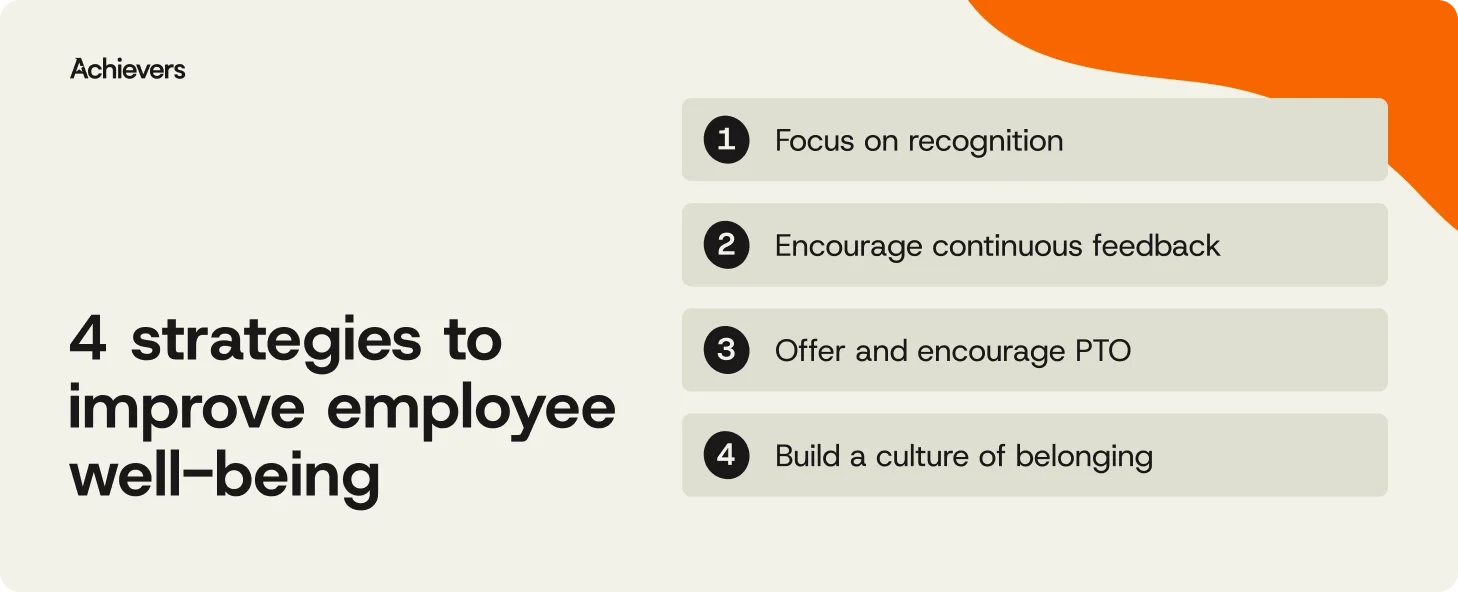Table of contents
Create a culture that means business™
Schedule a demo with an Achievers solution expert today.
Employee well-being is key to any successful business, but let’s be honest — today’s work environment isn’t making it easy. With remote and hybrid models blurring the lines between personal and professional life, workplace burnout and isolation are on the rise. The good news? These challenges also bring opportunities to do things differently.
When employees feel that their company truly cares about their well-being, they’re 73% less likely to experience burnout. That’s a compelling reason to make a change.
So, why should you care? Because prioritizing employee well-being doesn’t just make people feel good. It’s what fuels productivity, strengthens your company’s resilience, and keeps your workforce engaged for the long haul.
4 strategies to improve employee well-being
Employee well-being is far too often used as a buzzword. In reality, it’s a real priority that impacts how your team shows up every day. According to a 2024 survey from Gallup, one in four CHROs have made well-being a top organizational priority this year.
Here’s how you can create a workplace where well-being is front and center:

1. Focus on employee recognition
Recognition isn’t a luxury; it’s the fuel that keeps the engine running. In fact, research from the 2024 State of Recognition Report found that 45% of employees who are recognized at least monthly report feeling highly engaged at work. That’s a powerful reminder of how impactful regular recognition can be.
Here’s how to make it work for your business:
- Always-on recognition: Make it part of your culture. From leadership to peers, recognition should happen regularly — big or small.
- Points-based rewards: Let employees earn and share points, which can be redeemed for rewards they’ll love.
- Personalized rewards: Skip the generic “employee of the month” plaques. Let employees choose what they want from a custom rewards marketplace.
- Instant recognition: Recognition shouldn’t wait for a special occasion. Make it personal, specific, and in real-time.
2. Encourage continuous feedback
You can’t improve what you don’t understand, and waiting for annual surveys to give you the full picture isn’t enough. Taking advantage of employee feedback tools keeps you in tune with your team’s needs, so you can act on insights before they become problems.
- Use modern feedback tools: Say goodbye to long, tedious surveys. Use quick, easy tools like pulse surveys or AI-powered chatbots.
- Act quickly: Feedback is only useful if you can turn it into action fast.
- Anonymous feedback: Make it easy for employees to be honest, and ensure their input leads to meaningful change.
- Celebrate what’s working: Don’t just focus on problems — celebrate the wins, too.
3. Give employees plenty of PTO — and encourage them to use it
Don’t think of PTO as a bonus. Think of it as an invaluable part of keeping your team feeling and performing at their best. The last thing you want is a team that feels like they’re running on empty, so give your employees the time they need to unplug and recharge.
- Offer generous PTO: Give your team enough time to truly disconnect.
- Lead by example: Leadership should take time off too, setting the tone for the rest of the team.
- Make PTO a priority: Consider mandatory vacation days or fun challenges to encourage time off.
- Normalize unplugging: Create a culture where taking breaks is seen as smart, not slacking.
4. Build a culture of belonging
When employees feel like they truly belong, they show up differently. How differently? The Belonging Blueprint Report from Achievers Workforce Institute (AWI) found that 48% of employees who feel like they belong are their most productive selves at work. Plus, 56% would recommend their workplace as a great place to work. That’s the difference belonging can make.
- Embrace DEI: Make sure every employee feels seen, heard, and respected. Diversity, equity, and inclusion are what make your company strong.
- Create spaces for connection: Use ERGs, mentorship, and affinity networks to help employees feel supported and connected.
- Encourage psychological safety: Employees need to feel safe taking risks and sharing ideas without fear of judgment.
- Celebrate differences: Embrace the diversity of your team—it sparks creativity and innovation.
Elements of employee well-being
1. Physical well-being
Employees need to feel good physically if they’re going to bring their best energy to work. Physical well-being impacts everything—from focus and productivity to mood and overall engagement. Supporting your team’s physical health means creating an environment where they have the resources to stay healthy, comfortable, and energized.
Here’s how to make that happen:
- Offer wellness programs or gym memberships.
- Offer healthy food options.
- Create ergonomic workspaces to improve comfort.
- Encourage regular breaks to avoid burnout.
2. Mental and emotional well-being
Mental health affects everything from decision-making to collaboration. Employees who feel mentally supported are more likely to stay engaged, contribute ideas, and be productive. But mental well-being requires more than just offering a quiet room for meditation.
Here’s how you can create an environment where mental health is a priority:
- Build a culture that supports stress management.
- Provide mental health resources like counseling services.
- Offer mindfulness programs to help employees stay balanced.
- End the stigma around mental health so employees can seek help when needed.
3. Social well-being
Work can be isolating if employees don’t feel connected. Strong relationships at work aren’t just a nice bonus; they’re essential for motivation and collaboration. A team that feels connected will always be more productive and engaged.
Here’s how to build those meaningful connections:
- Encourage collaboration and team-based goals.
- Plan team-building activities to strengthen bonds.
- Set up regular social events to support connections, whether remote or in person.
4. Financial well-being
Financial stress isn’t just a personal issue — it can show up at work, too. When employees are financially secure, they’re more focused, engaged, and less distracted by money worries. Offering financial well-being support is just as good for your employees as it is for your business.
Here’s how you can help employees feel secure:
- Offer competitive pay and benefits.
- Provide financial resources on budgeting and saving.
- Invest in professional development to give employees confidence in their future.
5. Career well-being
When employees feel like their work is going somewhere, it makes a world of difference in their motivation and engagement. Need proof? Achievers’ 2024 Engagement and Retention Report found that 48% of employees whose company prioritized career equity saw themselves having a long career in their current workplace. Goodbye turnover. Hello, long-term success.
Here’s how to invest in your employees’ careers:
- Provide clear career paths and opportunities for growth.
- Offer training programs to help employees develop new skills.
- Encourage mentorship to help employees build confidence and experience.
Why is employee well-being important?
Employee well-being is the heart of a successful company. When employees feel supported in their health, growth, and work-life balance, they show up as their best selves — ready to take on the world.
Here’s why it’s so important:
- Productivity: Employees who feel supported are more engaged, focused, and productive.
- Absenteeism and costs: Prioritizing well-being means fewer sick days and reduced burnout, saving on costs.
- Retention: When employees feel cared for, they’re more likely to stay long-term, reducing turnover.
- Culture: A focus on well-being strengthens your workplace culture, making it more supportive and collaborative.
- Reputation: Companies that invest in well-being become employers of choice, attracting top talent and building trust.
How to measure employee well-being
Measuring employee well-being is about understanding how your team is really doing, inside and out. It means going beyond the numbers and listening to the people behind them. Here’s how you can get a clear picture:
- Look at absenteeism, healthcare use, and injuries: These stats give you a solid sense of physical health and safety in the workplace. If something’s off here, it’s time to pay attention.
- Keep an eye on productivity and turnover: High turnover or dipping productivity? These are red flags that can tell you something’s impacting employee well-being.
- Pay attention to employee sentiment: Surveys, one-on-ones, and team discussions are invaluable for understanding how your people feel. Are they engaged? Do they feel supported? It’s the why behind the numbers that truly matters.
Make employee well-being the center of your culture
Improving employee well-being isn’t something you can just tick off a to-do list. It’s about creating a workplace where employees feel supported, valued, and ready to bring their best selves every day. Sure, recognition, feedback, and growth are nice perks, but they’re also the foundation of a culture where people feel motivated and genuinely connected.
Achievers makes this a reality by seamlessly weaving employee recognition and feedback into the everyday flow of work. We help organizations create environments where employees feel seen, heard, and appreciated. The result? Teams that aren’t just showing up — they’re fully engaged and invested in what they do.
When well-being is built into your company’s culture, it’s not just your people who win. Your business does, too.



